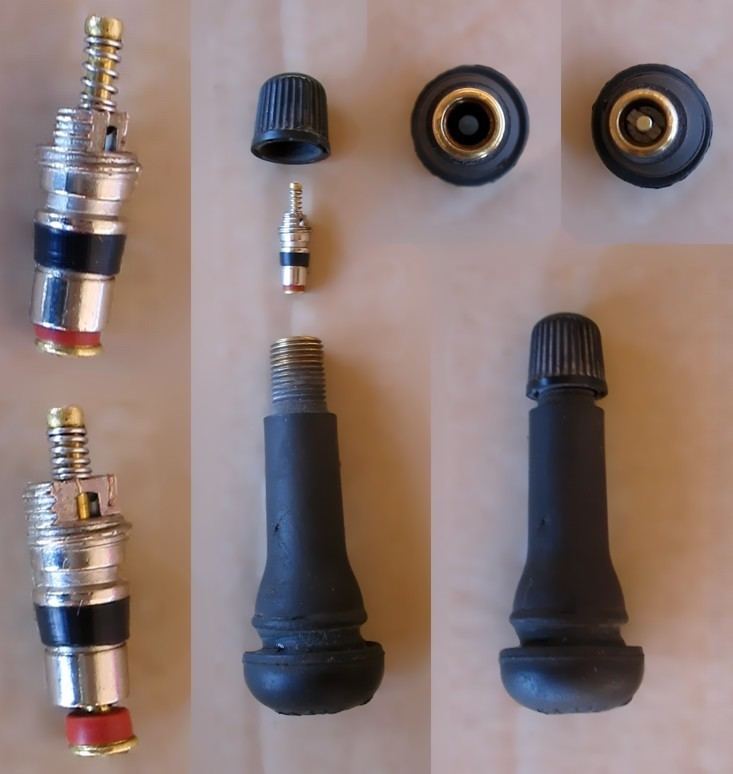 | ||
The Schrader valve (also called American valve) is a type of pneumatic tire valve used on virtually every motor vehicle in the world today. The Schrader company, for which it was named, was founded in 1844 by August Schrader. The original Schrader valve design was patented in the United States in 1893.
Contents
The Schrader valve consists of a valve stem into which a valve core is threaded, and is used on virtually all automobile tires and motorcycle tires and most wider rimmed bicycle tires. The valve core is a poppet valve assisted by a spring.
Uses
In addition to tube and tubeless tires, Schrader valves of varying diameters are used on many refrigeration and air conditioning systems to allow servicing, including recharging with refrigerant; by plumbers conducting leak-down pressure tests on pipe installations; as a bleeding and test port on the fuel rail of some fuel injected engines; on bicycle air shock absorbers to allow adjustment of air pressure according to the rider's weight; and in the buoyancy compensator (BC) inflators of SCUBA systems where the ability to easily disconnect an air hose (even underwater) without the loss of tank air is critical. Schrader valves are also widely used in high-pressure hydraulic systems on aircraft. Many domestic fire extinguishers use an internal valve identical to a Schrader valve, but with a lever on top to enable quick release of the pressurized content.
Valve
A Schrader valve consists of an externally threaded hollow cylindrical metal tube, typically of brass. In the center of the exterior end is a metal pin pointing along the axis of the tube; the pin's end is approximately flush with the end of the valve body.
Generally, all Schrader valves used on tires have threads and bodies of a single standard size at the exterior end, so caps and tools generally are universal for the valves on all common applications. The core of the valve can be removed or tightened with a tool.
A new development is Schrader valve stems with integrated transmitters for tire pressure monitoring systems (TPMS).
Cap
A valve cap is important on a Schrader valve because if one is not fitted, dirt and water can enter the outside of the valve, potentially jamming it or contaminating the sealing surfaces and causing a leak. Rock salt and other chemical de-icers used in the winter are especially damaging for the brass components in the Schrader valve.
Some valve caps have a rubber-washer seal (or a synthetic-rubber-washer seal) inside to help make a hermetic seal (airtight seal). Such a rubber-washer-sealing-type cap also helps prevent air from escaping from a slightly leaking valve. In addition, the rubber washer prevents the cap from loosening and falling off due to vibrations and hence being lost, by acting as a cushion between the cap and the valve stem and in this way damping the vibrations.
Schrader versus other valve types
Whereas Schrader valves are almost universal on car tires, bicycle tubes have Dunlop, Schrader or Presta valves. Both the Schrader and the Presta types are good at sealing high pressures. Their chief differences are that Schrader valves are larger and have springs that close the valve except when the pin is depressed. Schrader valves are used in a wide variety of compressed gas and pressurized liquid applications.
Presta valve stems are 6 mm diameter, whereas Schrader valve stems for bicycle tires are 8 mm, thus requiring a larger diameter hole in a bicycle rim. While not a concern on wider bike rims, it will weaken a narrow wheel rim, precluding their use on (road) racing bicycles. Another disadvantage of the Schrader is that the air chuck must depress the spring-loaded pin before air can flow during inflation, whereas the Presta valve relies solely on internal air pressure to keep it shut. This means that some air is lost while attaching and detaching pumps to Schrader valves, although this is usually minimal (most of the air which makes the "whooshing" noise when the pump is removed comes from the compressed air in the tube between the pump body and the attachment end, not the tire via the momentarily-open Schrader valve). To fill up a bicycle tire with a Presta-valved tube at a gas station requires an adaptor, while a Schrader-valved tube does not.
Dunlop ("British") valves are widely used on bicycles in certain countries including Japan and the Netherlands.
Dimensions
Schrader valves are classified by their material, diameter of intended rim hole, length, and shape.
and also:
The standard Schrader valve has the following threads:
For refrigeration, a 1⁄4 in (6.4 mm) male flare fitting is used, with the same internal thread as above.
